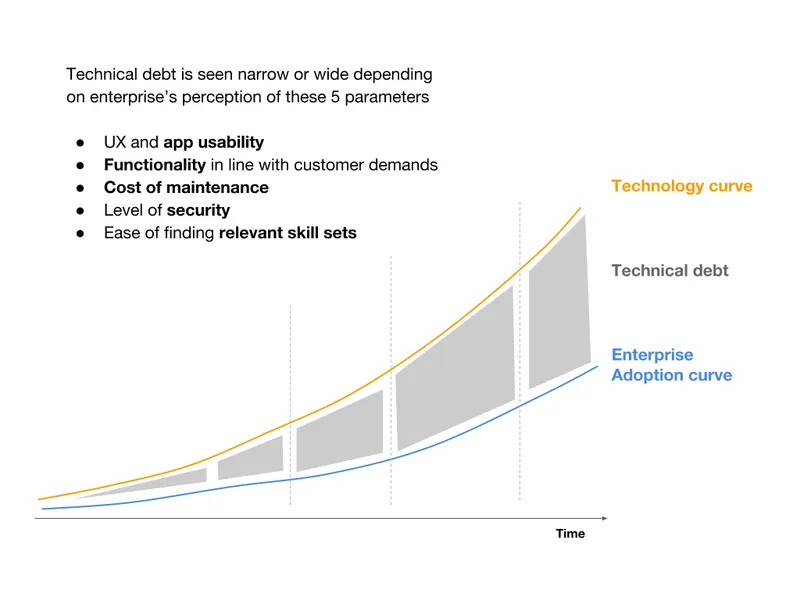Fast and future-proof with low code
Thanks to low-code platforms, enterprises can quickly ensure a seat in the digital world.

Enterprises have never been short of app ideas. But they have usually fallen drastically short of implementing them as fast as the market needs them. The reason maybe because of the slow and expensive way enterprises develop software. One might believe that agile development has completely replaced waterfall. The reality, however, is that even today software development to most enterprises is expensive, iterative, and risky.
Software development, of course, needs to be quick. The other concern is technical debt (Figure 1). Earlier, an application stayed valid in terms of functionality, usability, and maintainability for 20 to 30 years. Today, the pace of technological change is exponentially increasing the rate of software obsolescence. The software is a debt from day one today. Enterprises have roughly five years before it goes from a small technical debt to a large technical debt. The clock is ticking.
So how do enterprises catch up with both these realities?

A better promise by low-code platforms
Let’s step back in time. In the early 80s and 90s, there was an emergence of 4th generation programming languages (4GLs), that were different from the older 3GLs. Unlike the 3GLs (C++, Java etc.), 4GLs allowed the developer to focus on an app’s business logic and presentation instead of just writing lengthy codes. Developer productivity was the core promise of 4GLs and platforms like FoxPRO, MS Access, and PowerBuilder enabled rapid application development. But 4GLs weren’t all rosy for enterprises.
The highly proprietary nature of 4GLs resulted in vendor lock-in and didn’t give a way out from mounting enterprise software licensing costs. Additionally, they needed a lot of manual coding done. And their scope of use was limited to specific app scenarios determined by the technology vendors, leaving very little scope for customizations and explorations. However, the real killer for 4GLs today is that they were created in the pre-web, pre-mobile, and pre-digital era. Thus, they are not suitable for device, data, and integration requirements which enterprises now have. This is where the new wave of low-code application development platforms steps in. The promise is not to simplify coding, but to drastically minimise or eliminate the need for it resulting in faster and future-proof development.
Applications built using low-code platforms are modular by nature. So, the cost of an application change/enhancement is negligible. Although not offered by all low code platforms, some platforms offer open standards-based stacks which gives enterprises the openness that 4GLs lacked and importantly a way out of expensive vendor lock-in regimes.
Today, low-code platforms can be used for a wide range of requirements ranging from simple automation of paper-based processes to creating new systems ground-up. Some low code platforms can even help in modernising legacy systems.
These platforms offer pre-built legacy connectors and pre-fabricated components out-of-the-box. This makes legacy applications easily extensible to the digital world. Additionally, built-in DevOps and container management capabilities allow low-code platforms to utilise existing infra better and also deploy applications into, and between, existing/new infrastructures with zero friction.
At a higher level, low-code platforms help enterprises better align with the bold future of software development. Today, the business difference is in the data owned and not in the software used. Hence, three to four-year roadmaps can’t be an efficient way to build enterprise software. Model-driven, componentized assembly of software is the future and low-code platforms aid such emerging ways.
Thanks to low-code platforms, enterprises can quickly ensure a seat in the digital world. Only a fast and future-proof software development approach can help build applications that are flexible to change -- much needed when the vision of the application’s future is guaranteed to be invisible.
(Disclaimer: The views and opinions expressed in this article are those of the author and do not necessarily reflect the views of YourStory.)







